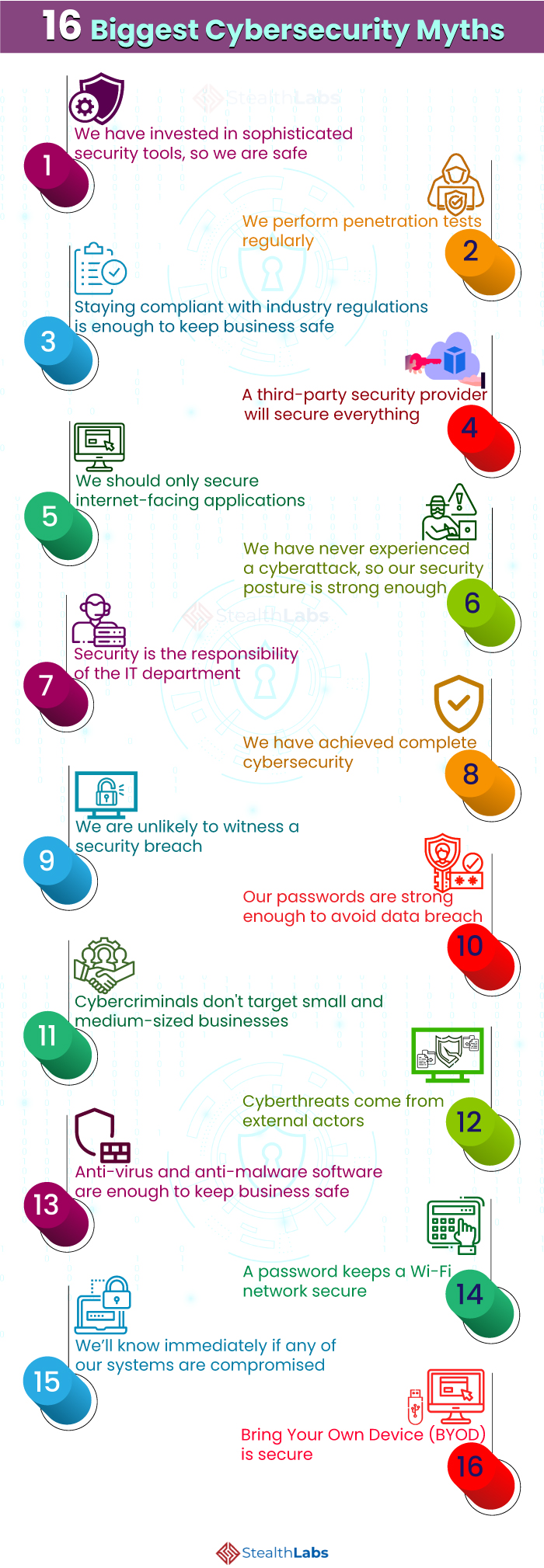Cybersecurity preparedness is paramount for ensuring business operations in the evolving cyber threat landscape.
As there are new data breaches and attacks daily, inadequate preparedness may result in catastrophic consequences.
However, despite the increased focus on securing the business, several myths and misconceptions about cybersecurity can prevent safeguarding the enterprise effectively.
Here are some common security myths in information security you need to debunk for adequate cybersecurity.
16 Biggest Cybersecurity Myths and Misconceptions

1) We have invested in sophisticated security tools, so we are safe
Organizations commonly mistake that investing in high-end security tools and solutions can help them build an invincible shield between their networks and cybercriminals. Sophisticated cybersecurity solutions are certainly an essential part of keeping your business secure, but it won’t shield you from everything.
The security tools and solutions are only fully effective if they are appropriately configured, monitored, maintained, and integrated with overall security operations.
2) We perform penetration tests regularly
Many businesses assume that they can prevent cybersecurity risks as they conduct penetration tests regularly.
But a penetration test is inefficient unless the organization can manage and rectify the vulnerabilities and loopholes in their security posture discovered during the test.
Moreover, the organization should consider the scope of the test, whether it covers the whole network, and allows exact replication of the most common cyber threats. It is also essential to consider whether the remediation focuses on the root cause of the risks.
3) Staying compliant with industry regulations is enough to keep business safe
Staying compliant with industry data regulations is essential for doing business, establishing trust, and avoiding legal consequences. But regulations often contribute only the bare minimum of security practices. Being compliant does not mean you are secure.
Organizations must consider whether the regulations are significant enough and the scope covers all the critical systems and data.
For instance, PCI compliance focuses on securing the credit card data, often excluding the other valuable information handled by the organization.
4) A third-party security provider will secure everything
Though the cybersecurity firm takes the responsibility of implementing and reviewing security policies to keep the company safe, it is crucial that you understand the cyber risks to your organization and how they are addressed.
Regardless of the security provider’s capabilities and credentials, you have a legal and ethical responsibility to secure critical assets.
Ensure that the security provider keeps you informed of their security roles, responsibilities, and capabilities, and any breaches.
5) We should only secure internet-facing applications
Organizations must secure their internet-facing applications. But it should not be their only focus.
For instance, your organization’s whole IT system may get compromised if an employee accidentally uses an infected flash drive. Therefore, organizations should have adequate controls to prevent and address insider threats.
6) We have never experienced a cyberattack, so our security posture is strong enough
Cyberthreats are continually growing in sophistication and complexity, and organizations need to strive continuously for cybersecurity. Your aim is not to achieve perfect security but to have a strategic security posture that helps you react quickly to a security incident and mitigate it before it causes much damage.
7) Security is the responsibility of the IT department
Undeniably, IT has a big responsibility for managing the cybersecurity of an organization. But it should not be solely responsible for security. As a security breach can have potential and long-lasting effects on the entire business, real cybersecurity preparedness is the responsibility of every employee.
8) We have achieved complete cybersecurity
Cybersecurity is an ongoing process rather than an outcome. New, innovative, and sophisticated cyberattacks evolve with time, putting your organization at continuous risk. So, you need to continuously monitor critical assets, conduct internal audits, and review security policies. The organization should embed cybersecurity practices into key business processes and invest in ongoing updates.
9) We are unlikely to witness a security breach
Many organizations assume that they are unlikely to experience a security breach because of the industry they’re in or their business nature. In contrast, every business is highly likely to suffer a security breach at some stage, so be prepared.
Every organization needs to be ready to react quickly to cyberattacks and have an incident response plan so that the impact on the business can be reduced.
10) Our passwords are strong enough to avoid data breach
Organizations often believe that their regular passwords are strong enough to keep their business safe. However, strong password practices are only the start.
A robust security system comes with a multi-layered defense. Organizations need to employ two-factor authentication and regular data monitoring.
11) Cybercriminals don’t target small and medium-sized businesses
Most Small and Medium-sized Businesses (SMBs) often think that they are immune to cyberattacks and data breaches. This is one of the top myths about cybersecurity that need to be debunked right now.
According to a recent Verizon’s Data Breach Investigations Report, 58% of cyberattack victims are small businesses.
SMBs aren’t explicitly targeted, instead they are victims of spray-and-pray attacks. Small businesses often lack advanced security software and skilled security teams, making them a softer target for cybercriminals.
12) Cyberthreats come from external actors
Undeniably, outsider threats are the most significant concern of an organization and should be monitored thoroughly. However, insider threats are equally dangerous.
Employee negligence, ignorance, and malicious behavior make insider threats a high-security risk than outsider threats.
In a recent Cyber Security Intelligence Index, IBM revealed that insiders carried out 60% of all cyber attacks.
So, the organizations must extensively monitor and deter insider threats.
13) Anti-virus and anti-malware software are enough to keep business safe
Anti-virus and anti-malware software is certainly imperative to keep the organization’s network and systems safe. But software won’t protect your entire IT infrastructure from all cyber risks.
For mature cybersecurity, the organization must adopt a comprehensive cybersecurity plan that encompasses everything from the incident response plan to insider threat detection and employee training.
14) A password keeps a Wi-Fi network secure
In remote working or shared workspace environments, employees often think that a password keeps their Wi-Fi network safe and secure. But all public Wi-Fi networks can be compromised, even with a password.
The passwords limit the number of users per Wi-Fi network. The users in the network can potentially gain access to the sensitive data that’s being transmitted.
So, employees should employ Virtual Private Networks (VPNs) to secure their data.
15) We’ll know immediately if any of our systems are compromised
In the present digital era, it can take months or even years to realize that your cybersecurity has been compromised, and your computer has been infected with malware.
For instance, it took four years for hospitality giant Marriott to notice a massive data breach that disclosed the personal and financial information of their 500 million guests.
The modern strains of malware are even more stealthy and difficult to detect.
16) Bring Your Own Device (BYOD) is secure
Though BYOD policies are definitely a cost-effective approach, they come with a plethora of risks. When employees bring in and connect their personal devices to the company’s network, they increase the threat landscape.
So, personal devices, including cell phones, laptops, wearables, and IoT devices, should be subjected to the security protocols put in place on the company’s computers.
In Conclusion:
Cybersecurity myths are a real threat in the present digital realm as they tend to prompt the organizations to deny real threats, helping cybercriminals wreak havoc.
Knowing that ‘cybersecurity myths are merely illusions’ is the first step towards developing a cybersecurity maturity.
Does your business support a strong security culture? Stealthlabs is Here to Help!

As a US-based IT Security Consulting Service Provider, Stealthlabs brings world-class capabilities and high-quality service to clients. With over a decade-long industry presence, we are committed to becoming the standard of excellence. Our information security services portfolio includes Compliance Advisory, Incident Management, Identity and Access Management, and Managed IT Security.
Recommended Stories:
- Cybersecurity in Financial Sector: Important Facts and Statistics
- Future of Cybersecurity: 5 Trends That Need Close Monitor!
- How to Implement ‘Cybersecurity’ in Your Project from the Beginning?
- Telemedicine and Cybersecurity: Securing Health Data!
- How To Create A Security Incident Response Plan (CSIRP)?

